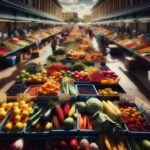Table of Contents
Understanding the trade tariff landscape
In recent months, the discussion surrounding trade tariffs has intensified, particularly for Canadian farmers who rely on exports to the United States. With the potential implementation of tariffs proposed by U.S. President Donald Trump, the agricultural sector is bracing for significant changes.
For many farmers, the stakes are high, as these tariffs could drastically increase shipping costs and impact profitability. Stan Vander Waal, owner of Rainbow Greenhouses in Chilliwack, B.C., expressed concerns about the looming tariffs, stating that a 25% tariff on shipments could render their exports unprofitable.
This situation highlights the precarious balance that farmers must maintain in an increasingly volatile trade environment.
The ripple effect on local agriculture
While the focus has been on exports, Vander Waal emphasizes that the import side of the equation poses an even greater threat.
The costs associated with importing essential supplies such as pots, plants, and fertilizers could skyrocket if counter-tariffs are enacted. This could lead to a situation where the overall cost of farming increases, further straining the financial stability of local farmers.
The BC Fruit Growers Association (BCFGA) has echoed these sentiments, noting that growers are already in a tough financial position after several challenging years. The combination of adverse weather conditions and declining production has left many farmers cash-strapped, making the prospect of additional costs from tariffs even more daunting.
Supporting local farmers through consumer choices
In light of these challenges, BCFGA president Peter Simonsen advocates for Canadian consumers to support local agriculture by purchasing locally grown produce. This not only helps farmers navigate the financial strain caused by tariffs but also ensures that consumers have access to fresher, more affordable options.
Simonsen points out that while tariffs may increase the prices of imported goods, they can simultaneously create opportunities for Canadian products to fill the gap. By choosing local, consumers can play a crucial role in sustaining the agricultural sector during these turbulent times.
Collaboration between farmers and government
As the agricultural community grapples with the implications of trade tariffs, the need for collaboration between farmers and government has never been more critical. Vander Waal emphasizes the importance of open dialogue to address the challenges facing the sector. By working together, farmers and policymakers can identify solutions that support Canadian agriculture and mitigate the adverse effects of tariffs. This collaborative approach is essential for fostering resilience within the farming community and ensuring the long-term viability of the industry.



